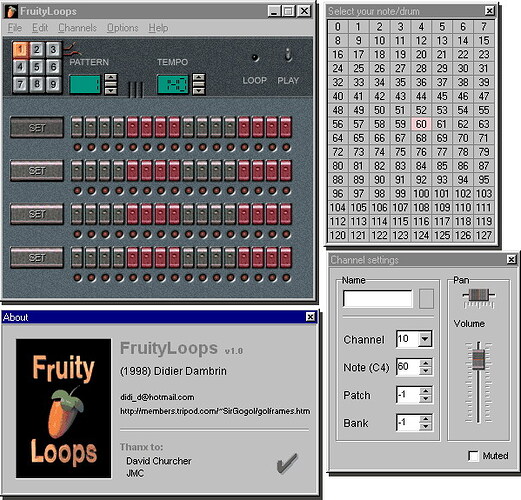Obviously that statement is a bit hateful upon Digidesign. Pro Tools is built for recording studios. It does multitracking flawlessly, without much effort, is laid out wonderfully, and intuitive. I have FL Studio in my arsenal. I have buzz in my arsenal. I have Ableton in my arsenal too, and of course Renoise. Everything goes to Pro Tools in the end because when you’re in an environment where keeping things documented and backed up is crucial to your existence, it is the best format. Once it’s tracked to disk and saved, everything involved is now in a folder in which you can label and back up. You then get a promise by Digi that your session will work an ANY subsequent release. A Pro Tools session recorded in 1994 will still open up on modern day hardware to dump into a console and re-mix or re-master. You can record a simple guitar/vocal demo at home and if it’s good enough take it to a studio and have everything already saved without track bouncing or any of that mess that takes valuable time.
This is coming from someone who used to be like you, I used to bash Digi all of the time, I took the recording classes and all of that but just stayed pretty much ignorant until I actually had to spend day in-out with it. I started production work for a studio owner and that’s what he used, so no matter what I used before-hand the end result always had to be pro-tools. Since it was there I just threw my elitist attitude out the window, read the manual, learned all it can potentially accomplish, and after about a month with it I got fast with it and the workflow was second nature.
Audiosuite plugins are also the shit, and I like to use them for glitch effect. Pluggo (rip cycling74 you just lost the majority of your marketshare not everyone is using ableton) in audiosuite is like having dblue’s glitch on steroids in close to a Renoise environment where you can apply the effects to drums by beat or even samples if you wanted to. So in that respect it wins over any audio software I’ve tried, the only one that can get close to that is Renoise and rendering selections to samples takes just a few more steps and less enjoyable overall.
FL Studio is my sound design program of choice for granular stuff and timestretching, it just does it well. (though the melodyne plugin functions well as a decent timestretcher too if you know how to use it like that) GRANULARIZING SAMPLES OPTION IN RENOISE PLEASE!!! That would provide a whole new approach to minimalism since you can have very short samples with random grains and have great textures out of small file size. It would create a whole new arena for “chiptunes” without a doubt, just different methodology.
I’ve always found pro tools less of a headache to edit with, coming from someone who’s spent years in software composing. It’s easier to play out 32 bars of keys in pro tools than it is renoise, so now we can talk about musical talent.
How about engineering talent? Does it strike you odd how Pro Tools emphasizes stereo and mono mixing tracks with the stereo audio in both left and right? It doesn’t blur your mix that way. The sound that comes out is “cleaner” because of that, and that’s one of the reasons why we haven’t switched completely yet.
And a rip off? Pro Tools LE comes free with their interfaces. The Mbox 2 pro they got right, is about the same as other audio interfaces and the preamps and conversion don’t suck. Sure they are no Avalon, but if I was a n artist who was serious about his music and recording a track at a time with a basic condenser mic and a guitar, then why would I use anything else? What would be the point? You make a track, plug a mic in, arm the track for recording and hit record. You’re going to get better sound out of that little box than anything by m-audio or any of that shit. Only one I’ve seen make a better small-form interface is Emu and they’re no more now.
Recently we just recorded a couple songs using a condenser mic and an mbox 2. What came out was clear and crisp, and was good enough to put on disc. I’ve used m-audio interfaces with FL, m-audio interfaces with Logic, lexicon interfaces with FL, steinberg interfaces, yamaha digital consoles, and so on. The M-Box 2 did better in most cases in the m-audio and just as good as a high quality steinberg interface or yamaha digital console. And for 500 bucks? To have something that works everywhere, in any real studio that got out of their mothers basement, anywhere in the world? That I can back up and open it again as long as Pro Tools is around left just as the day I left it?
You either need it or you don’t. My advice is to get to know it and work with it, use whatever else in the process of creating music if you must.
And that horrible release by propellerhead, I hope it doesn’t make version 2.0 because not only is there no need for it with everything they’ve developed thus far, Reason really does nothing more for me than a great sampler that I can get strings, pianos, guitar, and other multisampled real instruments with a vast library from everyone involved. The synths on it are horrible, give me FM8, Absynth, Sugar Bytes Unique, oatmeal, and Vaz Modular any day before I accept the aging synthesis by subtractor, the blandness of thor, and FL just does granular synthesis better and you can load your own waveforms. Reason synths=YUCK!
